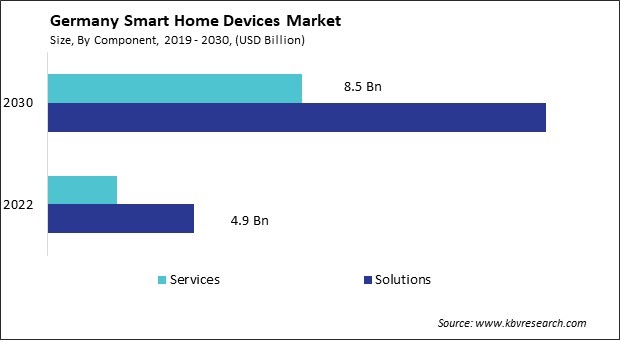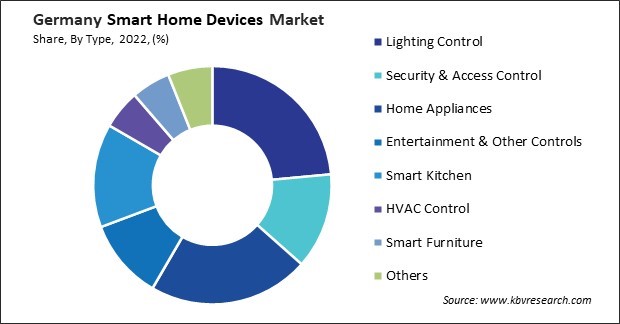Int'l : +1(646) 832-2886 | query@kbvresearch.com
Int'l : +1(646) 832-2886 | query@kbvresearch.com
Published Date : 15-Jul-2024 |
Pages: 91 |
Formats: PDF |
The Germany Smart Home Devices Market size is expected to reach $25 Billion by 2030, rising at a market growth of 17.3% CAGR during the forecast period.
Germany's smart home devices market has witnessed substantial growth in recent years, driven by technological advancements, increasing consumer awareness, and a growing inclination towards home automation. One of the key drivers of the smart home devices market in Germany is the rising adoption of Internet of Things (IoT) technology. IoT enables seamless connectivity between various devices, allowing users to monitor and control their home appliances remotely through smartphones or other connected devices. The proliferation of smart speakers and voice assistants has also played a significant role in driving the adoption of smart home devices in Germany.

Moreover, the growing awareness among consumers regarding energy conservation and sustainability has spurred the demand for smart home devices in Germany. Smart thermostats, for instance, enable users to regulate their home heating and cooling systems more efficiently, resulting in reduced energy consumption and lower utility bills. Similarly, smart lighting systems with sensors and timers help minimize energy wastage by automatically adjusting lighting levels based on occupancy and natural light conditions. Furthermore, the increasing emphasis on home security and safety has led to a growing demand for smart security cameras, doorbell cameras, and smart locks in the German smart home devices market.
The COVID-19 pandemic has also significantly impacted the smart home devices market in Germany. With lockdowns and social distancing measures in place, there has been a heightened focus on home environments as people spend more time indoors. This has increased demand for smart home solutions that enhance comfort, convenience, and productivity while addressing emerging needs such as remote work and virtual connectivity.
In Germany, the smart home devices market is experiencing a significant surge in online media usage as consumers increasingly integrate digital technologies into their daily lives. One of the key drivers behind the rising usage of online media in the smart home devices market is the proliferation of high-speed internet connectivity across Germany. With the widespread availability of broadband and mobile internet, German consumers now have constant access to online content and services through their smart home devices. This connectivity enables seamless streaming of music, movies, and television shows and access to social media platforms and other online resources.
Furthermore, the growing popularity of streaming services and digital content platforms has contributed to the increased adoption of smart home devices in Germany. Consumers in Germany are increasingly turning to devices such as smart speakers, smart TVs, and streaming media players to access their favorite content on demand. These devices offer convenient access to various online media services, allowing users to customize their entertainment experiences according to their preferences. The increasing adoption of smart home devices in Germany, such as smart TVs and speakers, reflects a growing trend in online media usage.
According to the Germany Trade & Invest, in 2021, 64% of German households owned a smart TV, while 33% had a smart speaker. Germans now spend between three to six hours per day online, out of a total media consumption of 10.5 hours. Notably, 75% of this online time is dedicated to streaming music or video content. This underscores the growing integration of online media consumption into the smart home ecosystem, reflecting a burgeoning trend in the German smart home devices market for connected devices.
Moreover, the integration of voice assistants into smart home devices has further facilitated online media usage. Voice-controlled devices enable users to interact with their devices using natural language commands, making searching for and accessing online content easier. This hands-free approach to media consumption has become increasingly popular among German consumers, driving the demand for voice-enabled smart home devices. Thus, the integration of high-speed internet, streaming services, and voice assistants is fueling the surge in online media usage and driving the adoption of smart home devices in Germany.
The smart home devices market in Germany is experiencing a significant surge in the adoption of lighting control systems. One key factor contributing to the growing adoption of lightning control systems is the increasing integration of smart home platforms and devices. Modern lighting control systems seamlessly integrate with existing smart home ecosystems, allowing users to control their lights through voice commands, smartphone apps, or automated schedules. Germany has long been forefront of renewable energy adoption and sustainability initiatives.
Moreover, emphasizing energy efficiency and sustainability drives demand for lighting control systems in Germany. Another factor fueling the adoption of lightning control systems is the growing awareness of the benefits of smart home technology. As German consumers become more educated about the capabilities of smart home devices, they are increasingly inclined to invest in solutions that offer convenience, security, and efficiency.
Additionally, advancements in wireless communication technologies and the proliferation of affordable smart home devices have made lightning control systems more accessible to a wider range of consumers in Germany. Therefore, the surge in the adoption of lighting control systems in Germany is driven by seamless integration with smart home platforms, growing consumer awareness, and improved accessibility due to technological advancements.

In Germany, the smart home devices market is vibrant and growing rapidly, driven by technological innovation, energy efficiency initiatives, and an increasing focus on home automation and connectivity. One of the prominent players in the German smart home devices market is Bosch. Bosch offers a comprehensive portfolio of smart home devices, including connected appliances, security systems, heating and cooling solutions, and energy management products. With a reputation for engineering excellence and a commitment to sustainability, Bosch has established itself as a trusted brand in the German industry, catering to consumers who value quality, reliability, and innovation in their smart home products.
Another major German smart home devices market player is Siemens, a global leader in electrification, automation, and digitalization. Siemens offers many smart home devices, including home appliances, home automation systems, and energy management solutions. 'The company's focus on cutting-edge technology, energy efficiency, and seamless integration with other smart home ecosystems resonates with German consumers seeking intelligent and sustainable home solutions.
German multinational conglomerate ABB is also a significant player in the German smart home devices market with its ABB-free@home® system. ABB-free@home® offers a comprehensive solution for home automation, allowing users to control lighting, heating, shading, and security systems via a central interface or mobile app. The company's expertise in building automation and electrical solutions makes it a preferred choice for consumers and businesses looking to transform their spaces into smart, connected environments.
In the smart lighting segment, companies like Osram and Philips Lighting (now Signify) are leading the way with advanced lighting solutions designed to enhance comfort, ambiance, and energy efficiency in German households. Osram offers a wide range of smart lighting products, including LED bulbs, fixtures, and controls, while Philips Lighting's Hue ecosystem provides customizable lighting experiences with features such as color adjustment, scheduling, and remote access.
Security-focused companies such as ABUS and Lupus-Electronics GmbH are addressing the growing demand for smart home security systems in Germany. ABUS offers a range of integrated security solutions that combine alarm systems, surveillance cameras, and access control devices to protect homes and businesses against intruders and unauthorized access. Lupus-Electronics GmbH specializes in IP-based video surveillance solutions, offering high-resolution cameras, video management software, and cloud-based remote monitoring and recording services. Hence, the German smart home devices market is characterized by a diverse ecosystem of companies offering innovative solutions across various product categories, including appliances, lighting, security, and automation.
By Component
By Type